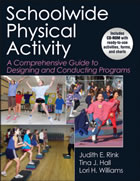VISIONS OF POSSIBLE PHYSICAL EDUCATION FUTURES
"The best way to predict the
future is to invent it" - Alan Kay, 1989

The NASPE PE 2020 initiative inspired almost
2000 people to share their visions of physical
education in the year 2020 and beyond. The
essays make for interesting reading. Significantly,
most writers shared the hope that physical
education in the future would inspire young
people to develop healthy and active lifestyle
habits.
Differences that did surface among the essayists
seemed mostly to be about HOW to achieve this
mission. There were lots of different perspectives,
which perhaps emphasize that "one-size-fits-all"
physical education programs will not work
in the future.
For example, we've all grown accustomed to
students being required to attend physical
education, and to do whatever we present to
them. But the more you read about changing
trends in public-school education it's clear
that we are moving towards greater individualization,
more choice, and less compulsion. Physical
education will likely need to do the same.
For those anticipating a 10, 20, or 30-year
future career in physical education there's
lots to think about.
It's easy to dismiss futuristic thinking
as some kind of gobbledygook, crystal ball
gazing, unrealistic guesswork. But of course
it isn't. Companies worldwide invest huge
financial resources into anticipating what's
going to happen in the future and how it will
affect them. While nothing can be certain,
a careful analysis of trends can reveal likely
challenges and potential opportunities.
In the past few years, groups such as the
US National Intelligence Council (NIC) have
used a technique known as "scenario creating"
as part of their thinking about and planning
for the future. The NIC has examined trends
and where they seem to be headed, and imagined
the possible consequences. Here's how the
process has been described:
In all the fictionalized scenarios,
we highlight challenges that could emerge
as a result of the ongoing global transformation.
The scenarios present new situations, dilemmas,
or predicaments that would cause upheavals
in the global landscape, leading to very different
"worlds." None of these is inevitable
or even necessarily likely; but, as with many
other uncertainties, they are potential game
changers.
What the NIC and CIA did was to bring together
experts from many fields and invite them to
brainstorm possible future scenarios. A link
to the documents containing them is included
below in case you want to read more. Here
is just one summary of a fictionalized scenario
to give you a taste:
A World Without the West.
In this world, described in a fictional
letter from a future head of the Shanghai
Cooperation Organization (SCO), new powers
supplant the West as the leaders on the
world stage. The US feels overburdened and
withdraws from Central Asia, including Afghanistan;
Europe will not step up to the plate and
take the lead. Russia, China, and others
are forced to deal with the potential for
spillover and instability in Central Asia.
The SCO gains ascendance while NATO’s
status declines. Anti-China antagonism in
the US and Europe reaches a crescendo; protectionist
trade barriers are put in place. Russia
and China enter a marriage of convenience;
other countries - India and Iran - rally
around them. The lack of any stable bloc
- whether in the West or the non-Western
world - adds to growing instability and
disorder, potentially threatening globalization.
Unlike the consequence of a loss of power
among Western nations, or the threat of nuclear
annihilation, the truth is that the world
would go on if physical education were cut
from K-12 schools. Of course, it's not something
that any of us would want but that doesn’t
make it an impossibility.
Over the past few weeks I've had the opportunity
to work with a group of K-12 physical and
health education teachers enrolled in Central
Washington University's online graduate program.
One of the challenges I presented them was
to respond to two possible future scenarios
of physical education. Here were their choices:
- A World Without Physical Education:
Physical education no longer exists in our
public schools. However, the importance
of getting children to lead healthy and
active lifestyles has been recognized and
achieved through alternative methods. How
did this happen? How did physical education
get eliminated? How did alternatives get
proposed and accepted? What does it now
looked like?
- A World
in which Public School Physical Education
is Thriving: Physical education
is thriving in a newly reconfigured public-school
educational system. As public school education
has changed, schools look very different.
Student schedules are more individualized.
Physical education has been re-imagined to
suit the needs of students in this vastly
different educational environment.
For your reading pleasure, two of these imagined
scenarios are included after this editorial:
Both were written by elementary school physical
education teachers. If you take the time to
read them I think you will see that either
outcome is a possibility. In other words,
physical education in the next two or three
decades could easily end up thriving or be
entirely eliminated.
Think back. Obesity rates have tripled since
the 1980s. Four-year high school physical
education requirements are a memory, and in
many schools physical education is optional.
Several well-known professional preparation
programs are gone. We've also seen some increased
support for the connection between physical
activity and academic performance. PEP grants
are providing some school districts the opportunity
to excel. Lots of changes are occurring around
us whether or not we notice them.
What concerns me are the potential consequences
of taking a passive approach to the future.
The passion that we see for deliberating best
teaching practices ignores an understanding
of the tenuous position we hold in public
school education. When schools change - which
they will - so will physical education. Are
we ready? I think not. It's not dissimilar
to those physical education teachers who wondered
what happened when their programs were cut.
They never saw it coming because they weren't
looking. Alan Kay explains the challenge with
the following quote attributed to Marshall
McLuhan:
"I don't know who discovered
water, but it wasn't a fish."
Kay suggests that McLuhan meant that if you're
immersed in a setting, you have an extremely
difficult time being able to see what's going
on. In other words, you have to get out of
the trees to see the forest. Something for
all of us to consider! Take a look at the
attached essays for a possible glimpse into
the future.
Steve
Jefferies, publisher pelinks4u
*Alan Kay, Xerox
engineer. Address before the 20th annual meeting
of the Stanford Computer Forum Xerox (Stanford
Engineering, Volume 1, Number 1, Autumn 1989,
pp. 1-6). Retrieved from http://www.ecotopia.com/webpress/futures.htm
NIH Documents Online
http://www.dni.gov/nic/NIC_2020_project.html
|


















